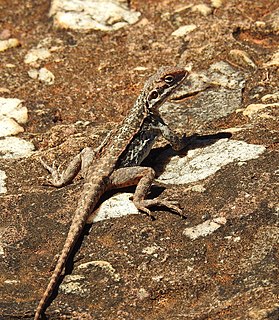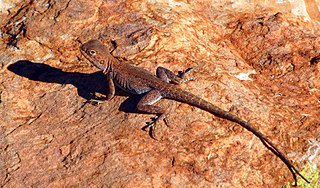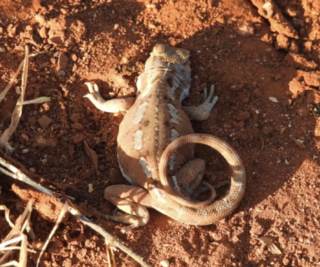The mulga dragon is a species of agamid lizard found in Western Australia. The species is up to 250 mm long, the length from snout to vent is 95 mm, with a long, slender tail that ends abruptly. The patterning over the legs and body is grey and brownish streaks. This provides an excellent camouflage on mulga trees, its usual habitat, it is also found beneath mulga leaf litter. Diporiphora amphiboluroides generally remains motionless and unobserved, this allows it to operate as an ambush predator and elude animals that would prey on it.

Ctenophorus is a genus of lizards, also known commonly as comb-bearing dragons, in the family Agamidae. The genus contains the most diverse group of dragon lizards in Australia. It is the largest group of Australian lizards and it has an extensive radiation in the arid zones. Many of the species of Ctenophorus have been grouped by a similar morphology. The informal names and groupings within this genus — rock dragon, crevice-dragon, ground-dragon, sand-dragon, and bicycle-dragon — are named after the mythological creature, the dragon.
Granite outcrops of Western Australia are weathered landforms that occur throughout the state of Western Australia, composed primarily of the rock type granite. All recognised types of this landform can be observed, commonly as bornhardts, but also as inselbergs, castle koppies and nubbins. Rising abruptly from the surrounding landscape they create a variety of microhabitats for plants, and provide seasonal resources and refuge for a range of animals. These areas thus have rich biodiversity and many endemic species. They are significant locations that tie in with the Aboriginal and European cultural heritage of Western Australia.

Pogona minor is a species of agamid lizard from a group commonly known as bearded dragons, and is found on the southwest coast and interior of Western Australia. This taxonomic name includes the widespread type known as western bearded dragon, Pogona minor minor which is widespread across West Australia between the Pilbara and the south coast, and the subspecies, Pogona minor minima is confined to the Wallabi Group of islands. There is another subspecies, Pogona minor mitchelli which lives in tropical woodlands of the Kimberley area of West Australia.
The spotted-thighed tree frog is a species of tree frog in the subfamily Pelodryadinae, found in Western Australia.

Pogona minor minima, the Abrolhos bearded dragon or Abrolhos dwarf bearded dragon, is an agamid lizard found only on islands at Houtman Abrolhos, and commonly named for this location. It is closely related to other bearded dragons found in Western Australia.

Ctenophorus reticulatus, the western netted dragon or western netted ground-dragon, is a species of lizard in the family Agamidae. It is found in South Australia, Western Australia and southern Northern Territory.

The Barrier Range dragon, Ctenophorus mirrityana, is an agamid lizard which has been newly described (2013) as a separate species from the tawny dragon. This species is endemic to Australia, restricted to just three sites in western New South Wales (NSW).

Ctenophorus fionni, also known as the peninsula dragon, Arcoona rock dragon or peninsula crevice-dragon, is a species of agamid lizard occurring only in South Australia.

The Mallee military dragon, also commonly known as the Mallee dragon or Mallee sand-dragon, is a species of agamid lizard occurring in the arid parts of southern Australia. The Mallee military dragon's specific name, fordi was named after Dr. Julian Ralph Ford (1932-1987). Dr. Ford was an ornithologist, herpetologist and chemist who worked at the Western Australian Museum. He collected the lizard holotype and many of the paratypes.

Ctenophorus isolepis, commonly known as the central military dragon, military dragon or military sand dragon, is a species of agamid lizard occurring in the arid parts of central and western Australia.

Ctenophorus butlerorum, also known commonly as Butler's dragon, the Shark Bay heath dragon and the Edel heath dragon, is a species of lizard in the family Agamidae. The species is endemic to Australia.

Ctenophorus caudicinctus, commonly known as the ring-tailed dragon or ring-tailed bicycle-dragon is a native species of agamid lizard occurring in rocky ranges and outcrops of Australia. Ctenophorus caudicinctus is most commonly found in the Pilbara region and offshore islands of Western Australia. The ctenophorus has 28 known species in the northern, southern, and western parts of Australia. It is recognized to be the most speciose group of Australian agamids.
Ctenophorus mckenziei, more commonly known as the Dwarf-bicycle dragon, is a species of endemic Australian lizard within the family Agamidae and genus Ctenophorus. Originally identified as the agamid Amphibolurus Mckenziei, the lizard had been identified within the regions of Western Australia and South Australia in which it occupied the shrubbery and woodland areas as its habitat. It was subsequently transferred to the genus Ctenophorus along with other Agamid species in which it shared similar morphology and characteristics. The name “Mckenziei” is in reference to Norman Leslie Mckenzie, who was a zoologist and discovered the existence of the lizard. Listed on the IUCN red list page, threats to its population numbers are detailed of least concern, however their numbers face threat due to habitat loss, climate change, and feral predators.
Ctenophorus nguyarna, commonly known as the Lake Disappointment dragon is a species of agamid lizard occurring in low samphire shrubs fringing the remote Kumpupintil Lake, Western Australia.

Ctenophorus parviceps, commonly known as the Gnaraloo heath dragon or northwestern heath dragon is a species of agamid lizard occurring in pale coastal sands and shell grit with open heaths and beach spinifex, between the North West Cape and Carnarvon, Western Australia and on Bernier Island. The Gnaraloo Heath Dragon is a lizard that can be found along the coast of Western Australia between Exmouth Gulf and Shark Bay, and is also known as the Northwestern Heath Dragon. It is native to Australia and usually inhabits sandy coastal dunes. The species’ longevity is 3–50 years and its population density is extremely low. The Gnaraloo Heath Dragon is a member of the Agamidae family, which contains 15 genera. The lizard is under the Ctenophorus genus which has up to 33 species. This genus shows the most morphological and ecological diversity out of the three large agamid genera. 83% of the lizards in this genus lack a crest, while 17% possess crests. They are smaller than most agamids but do have relatively large heads. The Gnaraloo Heath Dragon can be differentiated from related species by a series of spines on the tail's base, a pale-grey brown broad vertebral band along its back, and hour-glass bars extending upwards to meet the pale vertebral band. It is usually 45mm in terms of length, measuring from snout to vent.
Ctenophorus rufescens, commonly known as the rusty dragon or rusty-crevice dragon is a species of agamid lizard occurring in granite outcrops featuring open expanses strewn with exfoliated rock, in arid north-western South Australia, south-western Northern Territory and adjacent Western Australia.
Ctenophorus tjantjalka, also known as the ochre dragon, is a species of agamid lizard occurring on low, weathered, crumbling outcrops and stony hills in arid South Australia, from the Painted Hills north-west to the base of the Everard Ranges.

Ctenophorus vadnappa, commonly known as the red-barred dragon or red-barred crevice-dragon is a species of agamid lizard occurring in rocky outcrops and ranges in semi-arid to arid South Australia, from the northern Flinders Ranges to hills north of Lake Torrens.














